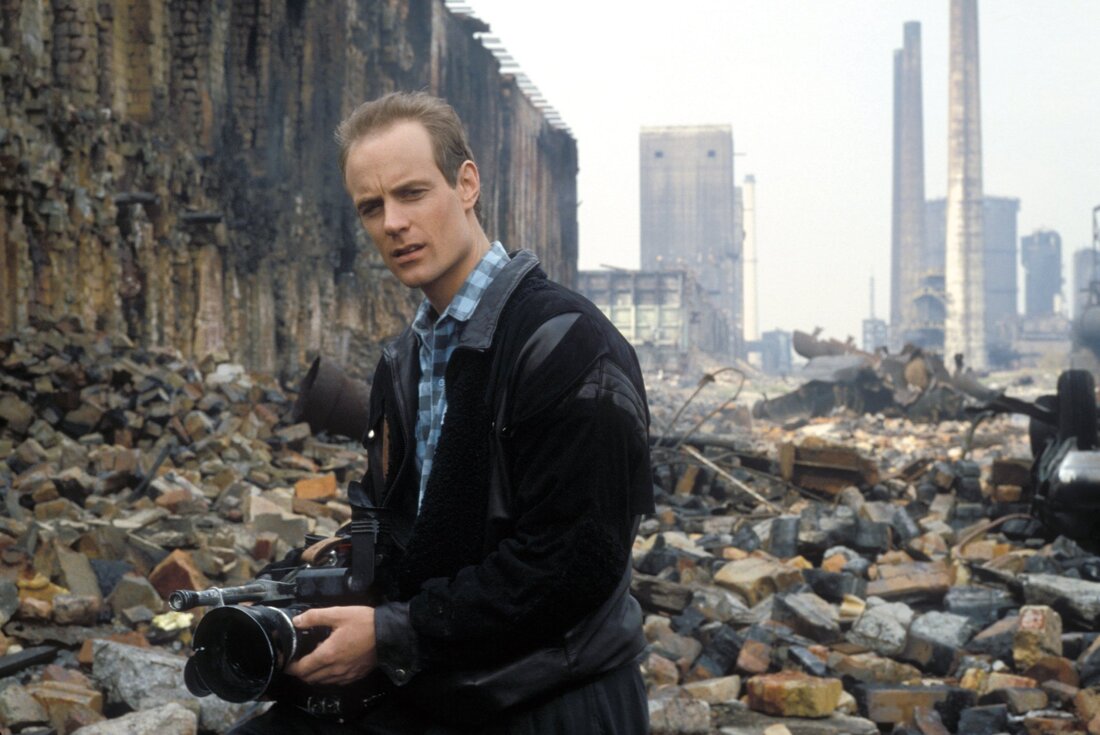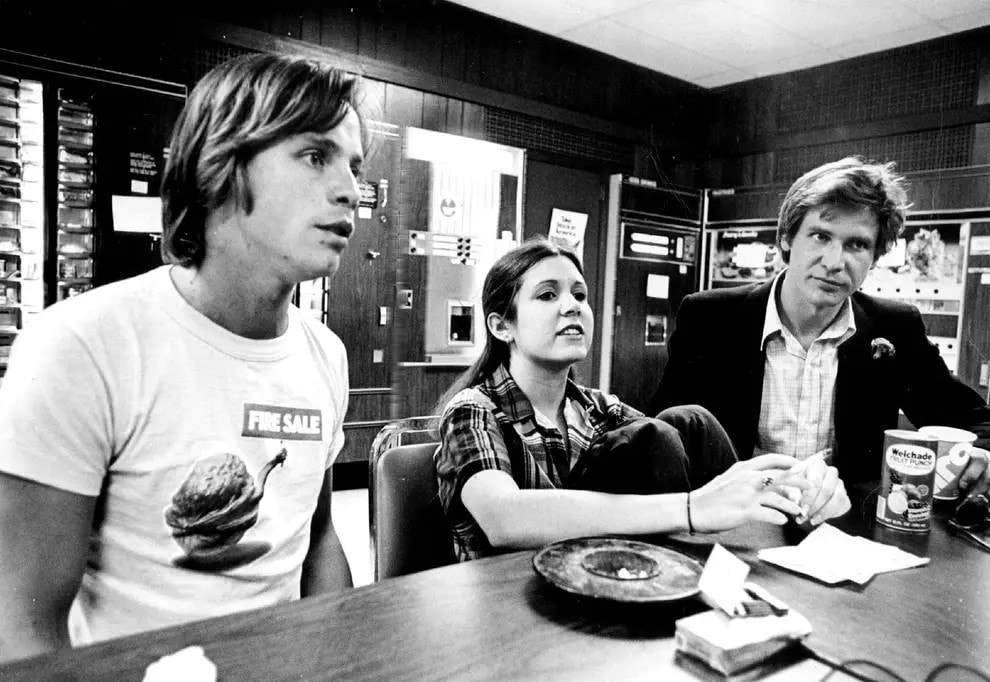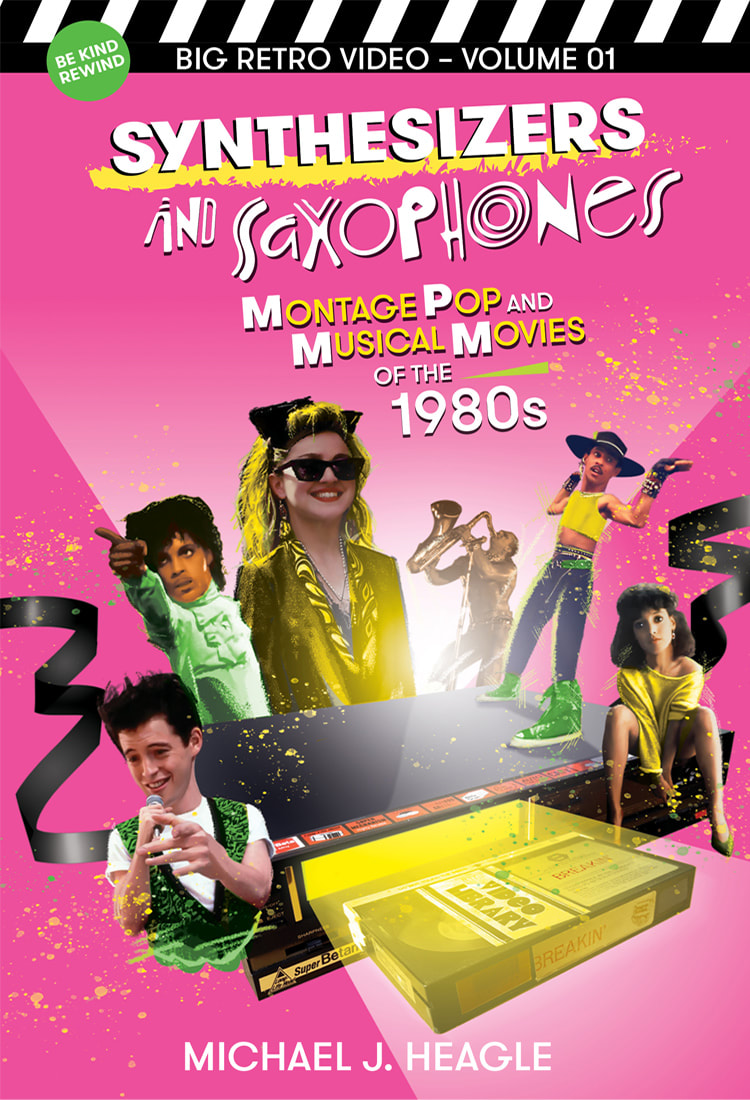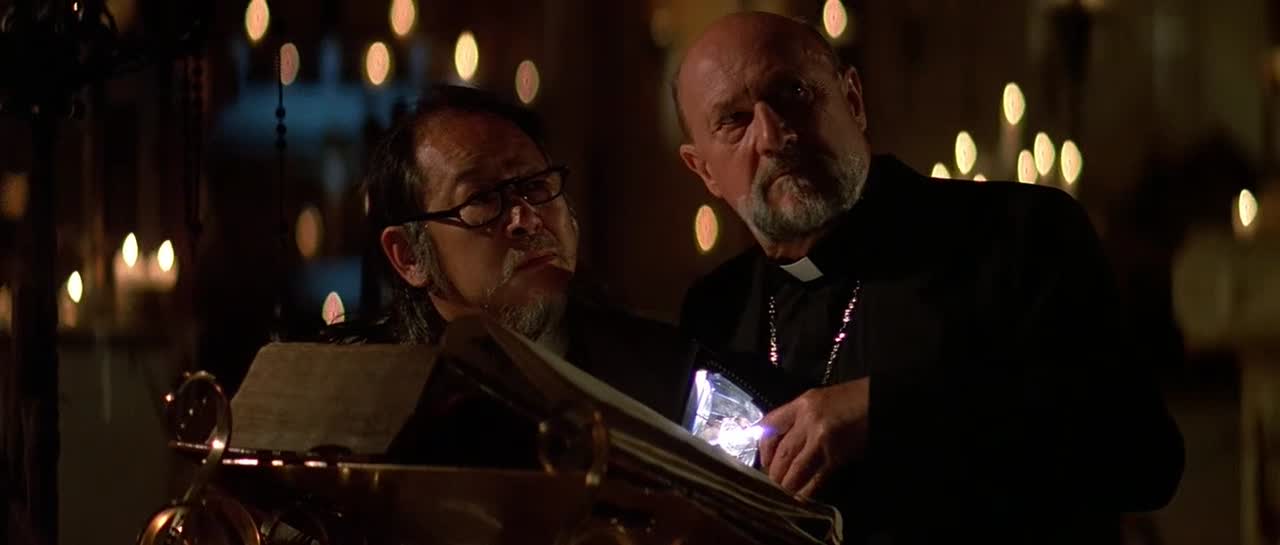|
Here's a paper I wrote in school. The year is 1987 or so...
In his article Who Programs You? The Science Fiction of the Spectacle, Scott Bukatman proposes that we live in the era of the blip, that we have become a blip culture. This is perhaps nowhere more true than in the British production of the original movie, Max Headroom. The politics of the blip culture are already firmly entrenched in the philosophy (or lack of philosophy) that makes up postmodernism. In this essay, I aim to get a grip on the greasy entity postmodernism, and see how its ethics have found their way into the sadly unsuccessful American television series that followed the original film Max Headroom by Rocky Morton and Annabel Jankel. Max Headroom is perhaps the first and last of the truly postmodern items to make a flash of an existence in American broadcast television. All that has followed is postmodern by default only -- as some critics state, the surface gloss of all mass media, being simulacra without origin, are in themselves postmodern. Only MTV and its spawn retain a postmodern attitude today, and even that has become and endless loop parody of itself. In the postmodern age, media software doesn't die, it just gets reused. And reused, and reused. Ad nauseum (literally). The world proposed in Max Headroom is the manifestation of theory, of Marshall MacLuhan made fact. In it, telejournalist-cum-adventurer Edison Carter is recreated as data in order to replace him as on-screen talent, reborn into the program or artificial intelligence named Max Headroom. This simulation of simulation (a TV celebrity made from a TV celebrity) is at the heart of the film. It is the schizophrenia of the postmodern condition made literal. Edison survives his run in with corporate- hired punks, and the computer "child" double Max escapes the lab -- as Max is a direct read-out of most of Edison's brain material ("people translated as data"), there are now two similar but different Edison Carters running around. Max is Edison, and Edison might be more like Max than he thinks, for Edison is as much a "talking head" as the disembodied Max is. In a later episode of the American series, Edison is confronted by a young boy who proclaims, "he does look like Max Headroom." Edison replies, "no actually, he looks like me," and does a Max-like smile. Which is more real, the real or the simulated? Edison, Network 23's highest rated journalist, is now capable of getting twice the air time, for like McLuhan explained, our post modern technological capabilities function as the "extensions of man." (Kuhn, p.197) The Max/Edison duality is made even more schizophrenic by the presence of Theora Jones, his "controller," back at base. Id, ego and superego become evident in the trinity: Max is the Id, seeking humor as pleasure and reveling in the trashy tropes of "twenty minutes into the future;" Theora is the ego, trying to keep both Max and Edison in line; and Mister Carter is the superego, out to punish wrongdoers as self-appointed voice of society. As Vivian Sobchack puts forth, "throughout the last decade, even our bodies have become pervasively re-cognized as cultural, commodified, and technological objects." (Sobchack, p.237) All of these are true of Edison Carter. When he is reincarnated as Max, he is remade in a completely technological form, a form which is commodified (Max becomes the hot property of Big Time television when his CPU is given to Blank Reg) almost as much as Edison is ("he is our best known reporter. His show is top rated prime time, he satellites globally"). Edison and Max are products "'constructed' and 'replicated...' a 'self' always (re)produced and projected as an image available to others." (Sobchack, p.237) And though Edison has a life off camera, seen in his relationship with his coworkers, his corporate bosses, or his enemies, it is the TV story that counts. Getting it on air makes it valid, real, better than reality... As Bukatman says, "television... due to its mass penetration and continually functionally national and global networks, is not to be seen as presenting an image or mirror of reality, but rather as a constituent portion of a new reality." (Kuhn,p.196-7) In terms of its post modern surface, Max Headroom excels at excess. Back in 1987, the American series was costing about a million and a half dollars per episode to produce, a figure that comes into focus when you examine the show's style. Like Blade Runner, Max Headroom is ready to "accept or embrace trashed out, crowded, and complex urban space," to embrace pastiche, the "nonhierarchical collection of heterogeneous forms and styles from a variety of heretofore distinguishable spaces and times." (Sobchack, p.227, 230) It's mise en scene is comparable to and inspired by Blade Runner, for it is a child of the BladeRunnerian ethic: fill the 21st century space with the clutter of two previous centuries. The world that Max inhabits is "a thoroughly commodified culture," evidenced by the brand name corporate stranglehold of companies like Zik Zak (an embodiment of late-eighties Jap bashing, just one of the series' culture flaws). The "new" is turned into instant junk -- ratings control the spending habits of the corporations, which control the spending of billions of viewers. As a result, the Network 23 board of directors plays their game much like Wall Street did in the eighties, buying and selling, changing programs and policies in split seconds to keep up with the constant input of data from consumers who are changing channels. This commoditization has taken on new levels, however. In the original film and in several episodes to follow, there is a fringe element in the society who make their money selling human body parts stolen from the dead or dying. Breugel and Mahler, for example, listen to police band radios to get the jump on the nearest fatal accident, and cash in their finds at Nightingales Body Bank (through the night depository window, no less). It is this new commoditization that defines Edison's role in the pilot for the series: Breugel and Mahler dispose of Edison in this way, and when Theora finds him, she finds his definition. The words "HEAD, MALE" appear on a body tag affixed to his ear, once again illustrating the underlying principles of TV news anchors as meat. Max Headroom is also an illustration of cultural recycling, of intertexts at work. The character Max began as a hip, cable TV talk show host, proceeded to gain a series and become spokesperson for softdrink megacorporation Pepsi -- tell me that's not grounds for election to the hall of cultural landmarks of the eighties. Edison's persona is not unlike previous journalist incarnations from cinema history. Not only does he have his girl friday, but he's mad as hell and he's not gonna take it anymore. It's a globally-potent Marshall McLuhan character with the patience of a drugged out Geraldo Rivera. It is as if 60 Minutes had gained a maniacal autonomy and had access to everything (and if Edison is a rebellious 60 minutes reporter, Max must surely be part Andy Rooney, part C3PO/R2D2). The choice of call numbers for the most powerful station in town (or is it the world?) is Network 23, which comes from a song title by German electronic music group Tangerine Dream, whose style has in many ways effected both the look and sound of science fiction, and the socio-cultural dogma that is cyberpunk. Crucial to the understanding of Max Headroom is the problematic concepts of media in the information age. It is interestingly post modern how, in the series, at least one reference was made per episode about how TV works. Not technically functions, but how it works as a powerful business and the key socializing force in today's society. When it couldn't fit into the plot, they would allow Max a soliloquy at the end of the episode, at which point he would bash the network, the advertisers, or the program planners responsible for allowing the show on the air. This is probably why it didn't last very long, for in it's kitschy postmod way, Max was stealing the pleasure out of an essentially pleasure producing medium. Viewers who were aware of what they were doing with TV (and what TV ritually did with them) could laugh, but those who watched it because it was the only thing on until Cosby said to themselves, "Hey, this cocky computer guy is telling me I'm stupid! That's the last time I watch this lousy show." It is Max Headroom's suicidal self reflexiveness that made it years ahead of its time, challenging the very forces that created it (much as Edison did from episode to episode). It subscribed to the theories put forth by Frederic Jameson of "aesthetic populism" and took it to new heights. Not only was the "'degraded' landscape of schlock and kitsch" beautified and given life, but made valid as high art. Society in Max Headroom's era seems to function according to the same ideal that Jameson's words suggest, but unlike much of the dark-future science fiction of the 1980's, the power base is peculiarly democratic. The masses have a say: billions of TV users, though they may have lost the right or the will to vote long ago, they've gained (or kept) the right to vote for (other) celebrities. Ratings are as good as the voter's vote, better financially. In addition, control does not rest solely in the hands of the corporate power elite, or in the power circle of media giants like Network 23. Blank Reg and Dominique seem to be doing alright with their pirate television station, Big Time. Big Time, a kitschy, one-man MTV run by an aging, sixty-year-old punk rocker (the ultimate post modern symbol!), is capable of making a play in the ratings war with the help of Max. Like most cyberpunk cinema, Max Headroom neither embraces nor condones technology. It uses it. Society is still hyperconsumerized, so it still needs stuff, toys, tech. Technology is not feared, and usually not awe- inspiring either. We as viewers might enjoy seeing Theora control vidicams and securicams from her greasy terminal at Network 23, but Edison mostly takes it for granted. Reg and Dominique are split on whether or not to be amazed or disappointed at the enigma that is Max Headroom's CPU, and Grosman is just put off by Bryce Lynch's irritating combination of childishness and technobabble. Grosman on Lynch's creation, Max: "Max Headroom! What the hell? Goddamn it! Get that babbling clown off the screen. Kill it... It is a computer generated geek!" Tech is just there, it is both user friendly (as is Max) and deadly (which brings us to the nasty problem of Blipverts). At the heart of the original Max Headroom is Blipverts, an advertising tool designed by Bryce Lynch which enables 30 seconds of advertising information to be compressed to five seconds. An unusual side effect is that it causes slothful viewers to explode. It is precisely the "bombardment by these 'short, modular blips of information,'" as Scott Bukatman defines as the soul of blip culture, that is at the heart of Max Headroom. (Kuhn, p.196) Information jammed into small spaces is ever present in the story. Max himself is victim of information overload, for he thinks so fast he stutters, glitches -- he is an artificial intelligence simulacra, spewing forth data (quips, wit, one liners) and mugging for the eternal camera as fast as his speech processors will allow, sometimes faster, a collection of the speedy "pseudoevents" proposed by Jameson (Sobchack,p.237). Edison Carter has done what we all have in the blip culture, albeit literally: "the human subject has become a blip, ephemeral, electronically processed, unreal." (Kuhn, p.196) In the tradition of post modernism, there is an air of pessimism at work here, though sanitized. All is not without hope: Carter and Max continually win out against evil in the series, with varying degrees of success. People can at least afford color TV's, even if they cannot afford housing, and someone like Reg (a "blank," unemployable and nonexistent) can afford ratty telecommunication equipment. Still, Breugel and Mahler sell dead bodies, advertising can blow the skin off people's heads, and one's buying habits are utterly controlled by faceless corporate entities. As Arthur Kroker and David Cook state in their book, Panic Encyclopedia: the Definitive Guide to the Postmodern Scene, "Max is living out a panic conspiracy in TV as the real world. His moods are perfectly postmodern because they alternate between kitsch and dread, between the ecstasy of catastrophe and the terror of the simulacrum... Max Headroom, then, as the first citizen of the end of the world." Some thoughts on Star Wars 77 (after not seeing it for a while, decided to check it out at 5am this morning on Disney+ after seeing some HD clips)
Been resistant since the Special Edition -- turns out there were only about five or six egregious shots and one or two sound cues that should have been left alone. The entire Jabba scene excluded in that math, we shouldn't go there. Also Huttese is full bullshit, "crispuh" for "burned up" and jokey stuff like that. Tendency to have every Dewback screaming in every shot they appear was one of the few big irritants for me. When they were majestic, barely moving lizard hulks they inspired the imagination. Tattoine is really the best. Between sandpeople, jawas, rusty droids, the original cantina, the back streets of Mos Eisley, that perfect docking bay 94, the doors on the buildings, the mysteries unanswered. As I recently mentioned, C3PO never looked as good again. His level of physical damage in the Death Star is perfect. Death Star corridors never seemed repeated. Very cleverly arranged. First half rescued by 3P0 and R2D2 relationship/banter. Also Alec Guinness's looks at Han Solo are really priceless. Silent burns, each one, but never hatred. Call it "sophisticated bemusement." Public displays of affection are common. Obi Wan claps Luke's shoulder outside the Jawa ruin. Han pets Chewy, and leans on him. Leia touches Luke's back delicately after Kenobi's death. VERY GOOD. All of the added Millennium Falcon shots are truly great. The couple of added X-wing shots in the death star fight are great. But the original shots of the tie-fighters-versus Falcon aerial battle after the escape are truly transcendent pieces of model work. That long-lens stuff of the TIEs skimming past the Falcon are works of art. REALLY fucking hits the ground running when the three leads are together and never lets up. THIS was where the magic was. As funny as the droids are, they're just props. Leia and *young* Luke and Han is where the magic resided. Replicated in Empire, lost when Luke gets serious (thanks Yoda).
Efficiency in storytelling is like any other art form. Take music, for example. Some really sparse songs are fantastic, sometimes you need 48 tracks of overdubs.
When it comes to screenwriting, I would say I try to take after my filmmaking idol John Carpenter. It's a classic, ultra-sparse Hollywood style of show don't tell. Here's four ways JC (working under the nom de plume of Martin Quatermass) shows his skill at keeping things tight in the screenplay for 1987's PRINCE OF DARKNESS. Read the Screenplay Here
I'm inclined to put the exact effort necessary on the page. It's a document to get you to the screen, not a stand-alone work of art. It's like fancy fonts on an architectural blueprint. Or, it's like putting expensive aftermarket spoilers and stuff on a shitty import car. I want my screenplay to be a 71 Plymouth Barracuda. Just a monster under the hood. In short -- make the "What Happens" be so amazing that it doesn't require embellishment. |





